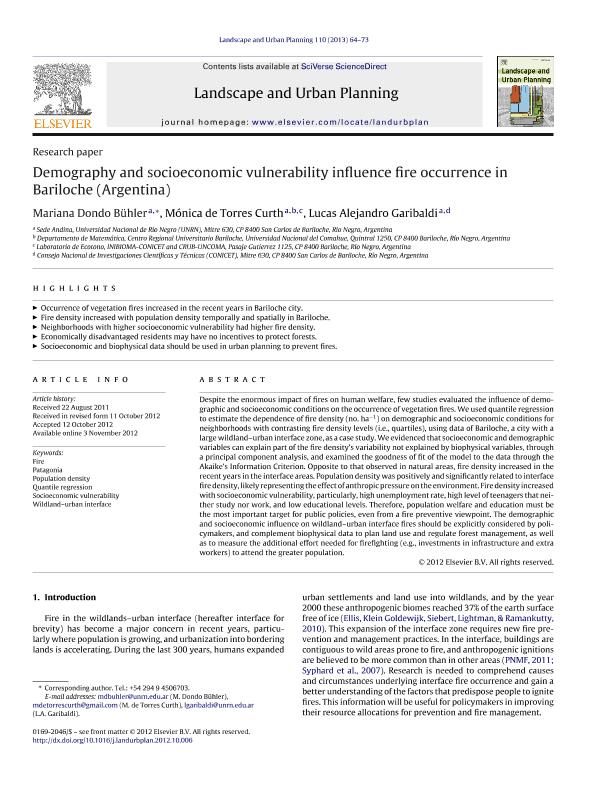Mostrar el registro sencillo del ítem
dc.contributor.author
Dondo Bühler, Mariana Beatriz

dc.contributor.author
de Torres Curth, Mónica
dc.contributor.author
Garibaldi, Lucas Alejandro

dc.date.available
2016-12-06T18:50:59Z
dc.date.issued
2013-02
dc.identifier.citation
Dondo Bühler, Mariana Beatriz; de Torres Curth, Mónica; Garibaldi, Lucas Alejandro; Demography and socioeconomic vulnerability influence fire occurrence in Bariloche (Argentina); Elsevier Science; Landscape And Urban Planning; 110; 2-2013; 64-73
dc.identifier.issn
0169-2046
dc.identifier.uri
http://hdl.handle.net/11336/8916
dc.description.abstract
Despite the enormous impact of fires on human welfare, few studies evaluated the influence of demographic and socioeconomic conditions on the occurrence of vegetation fires. We used quantile regression to estimate the dependence of fire density (no. ha−1) on demographic and socioeconomic conditions for neighborhoods with contrasting fire density levels (i.e., quartiles), using data of Bariloche, a city with a large wildland–urban interface zone, as a case study. We evidenced that socioeconomic and demographic variables can explain part of the fire density's variability not explained by biophysical variables, through a principal component analysis, and examined the goodness of fit of the model to the data through the Akaike's Information Criterion. Opposite to that observed in natural areas, fire density increased in the recent years in the interface areas. Population density was positively and significantly related to interface fire density, likely representing the effect of anthropic pressure on the environment. Fire density increased with socioeconomic vulnerability, particularly, high unemployment rate, high level of teenagers that neither study nor work, and low educational levels. Therefore, population welfare and education must be the most important target for public policies, even from a fire preventive viewpoint. The demographic and socioeconomic influence on wildland–urban interface fires should be explicitly considered by policymakers, and complement biophysical data to plan land use and regulate forest management, as well as to measure the additional effort needed for firefighting (e.g., investments in infrastructure and extra workers) to attend the greater population.
dc.format
application/pdf
dc.language.iso
eng
dc.publisher
Elsevier Science

dc.rights
info:eu-repo/semantics/openAccess
dc.rights.uri
https://creativecommons.org/licenses/by-nc-nd/2.5/ar/
dc.subject
Fire
dc.subject
Patagonia
dc.subject
Population Density
dc.subject
Quantile Regression
dc.subject
Socioeconomic Vulnerability
dc.subject
Wildland-Urban Interface
dc.subject.classification
Ciencias Sociales Interdisciplinarias

dc.subject.classification
Otras Ciencias Sociales

dc.subject.classification
CIENCIAS SOCIALES

dc.subject.classification
Ciencias Medioambientales

dc.subject.classification
Ciencias de la Tierra y relacionadas con el Medio Ambiente

dc.subject.classification
CIENCIAS NATURALES Y EXACTAS

dc.subject.classification
Estudios Urbanos

dc.subject.classification
Geografía Económica y Social

dc.subject.classification
CIENCIAS SOCIALES

dc.title
Demography and socioeconomic vulnerability influence fire occurrence in Bariloche (Argentina)
dc.type
info:eu-repo/semantics/article
dc.type
info:ar-repo/semantics/artículo
dc.type
info:eu-repo/semantics/publishedVersion
dc.date.updated
2016-12-06T16:31:16Z
dc.journal.volume
110
dc.journal.pagination
64-73
dc.journal.pais
Países Bajos

dc.journal.ciudad
Amsterdam
dc.description.fil
Fil: Dondo Bühler, Mariana Beatriz. Universidad Nacional de Rio Negro. Sede Andina; Argentina
dc.description.fil
Fil: de Torres Curth, Mónica. Universidad Nacional del Comahue. Centro Regional Universitario Bariloche. Laboratorio de Ecotono; Argentina. Universidad Nacional de Rio Negro. Sede Andina; Argentina. Consejo Nacional de Investigaciones Científicas y Técnicas. Centro Científico Tecnológico Patagonia Norte. Instituto de Investigación en Biodiversidad y Medioambiente; Argentina
dc.description.fil
Fil: Garibaldi, Lucas Alejandro. Universidad Nacional de Rio Negro. Sede Andina. Departamento de Ciencias Exactas, Naturales y de Ingenieria; Argentina. Universidad Nacional de Rio Negro. Sede Andina; Argentina
dc.journal.title
Landscape And Urban Planning

dc.relation.alternativeid
info:eu-repo/semantics/altIdentifier/url/http://www.sciencedirect.com/science/article/pii/S0169204612002873
dc.relation.alternativeid
info:eu-repo/semantics/altIdentifier/doi/http://dx.doi.org/10.1016/j.landurbplan.2012.10.006
Archivos asociados
